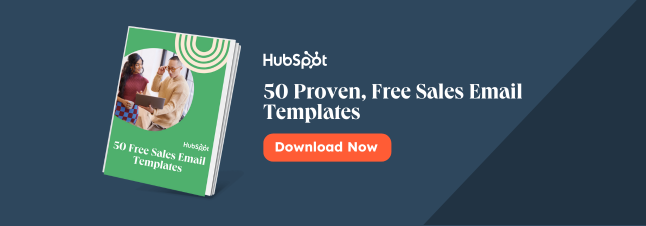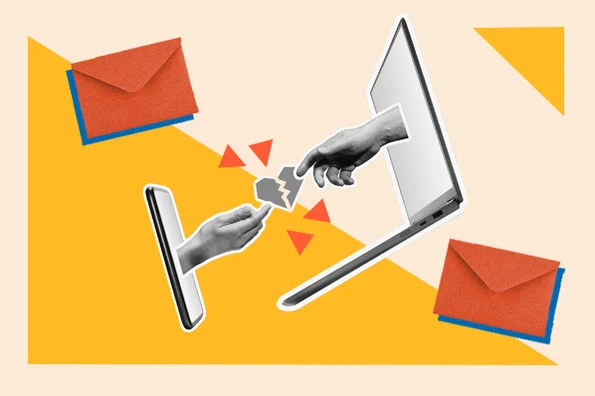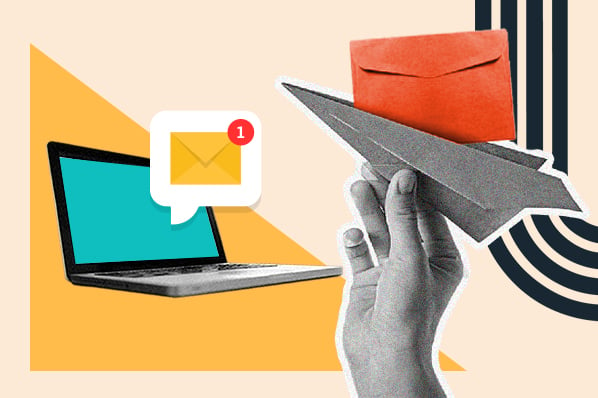With active email accounts expected to hit 5.6 billion by the end of 2019, it's no wonder email is the one sales and marketing trend that just won't go away.

But there's so much noise in our inboxes today. How do you stand out? For starters, avoid making these 13 mistakes guaranteed to send you straight to trash.
Email Mistakes
- Misusing reply all
- Forgetting to proofread
- Using a deceptive subject line
- Choosing a lazy greeting
- Not formatting your message
- Sending emails late at night
- Not including a signature
- Having no call to action
- Using a "creative" font
- Not using email shortcuts
- Following up too soon
- Sending an email when you really need to call
- Not getting to the point
1. Misusing reply all
Reply All is email functionality that can be used for good or evil. But which is which? Here's a quick refresher on when to use Reply vs. Reply All:
Use Reply All if …
- More than one person needs to know the email was responded to
- Other recipients will be confused if they don’t see you respond
- Your response will impact 70% or more people on the chain
Use Reply if …
- The email is addressed to you only
- Only one person needs to see your response
- You receive a company-wide email and you think more than .2 people will roll their eyes if you hit Reply All
If you don’t need to reply to all seven people on your email but do need another one or two people to be included in your reply, this is a great moment to hit Reply and CC the other relevant people on your message.
2. Forgetting to proofread
There's no excuse for misspellings in today's digital world. Even if you're just sending a line or two of text, run a quick copy and paste just to make sure a small error hasn't slipped by your Friday-at-4:00-PM eyes. Here are a few of my favorite tools:
- Microsoft Word's "Review" feature catches misspellings and punctuation.
- Hemingway Editor catches misspellings, punctuation, run on sentences, and passages that are difficult to read.
- Grammarly has a wonderful Chrome extension that edits your work in real time -- even in your email browser.
Once you've proofread for grammar and spelling, double check that your recipients name, company name, and email address are spelled correctly. No spell check will catch the missing "n" you leave out of a prospect's email address -- that's up to you.
3. Using a deceptive subject line
You've probably gotten one of these at some point in your career. It might look something like, "Re: Next week's meeting," or "Following up on yesterday's call." The problem is that you've never spoken with these people. Their subject lines are simply a ploy to get you to open, read, and respond.
Don't send this kind of subject line. It's lazy, dishonest, and deserves to be sent straight to spam. Looking for a better way to craft subject lines that grab attention? Check out these classics, try a funnier approach, or use these subject line tester tools on your old standbys.
4. Choosing a lazy greeting
If you've started an email with "To Whom It May Concern," you're guilty of using a lazy greeting. The internet has made it almost impossible not to be able to find out the name, email address, and professional title of the person you're emailing.
Whether you're addressing an email to a hiring manager or prospect, spend five minutes doing a little digging on LinkedIn to find out who you're speaking with.
Really can't find the name or title of your recipient? Simply address your email to the department you're attempting to reach. For example, if you're applying for a job, you might address the email, "Dear Hiring Manager," or "Dear Sales Team."
Just make sure you avoid old fashioned greetings like, "Dear Sir or Madam." Want to brush up on how to write a formal email? Click here.
5. Not formatting your message
In 2018, Litmus found 46% of all email opens happened on mobile accounts. So, if you’re writing eight-sentence long paragraphs without bullets or formatting, it’s likely a large portion of your readers will close your emails before they’ve read a single line.
And, let’s be honest, no one likes to read long emails -- even from desktop. Format your emails with short paragraphs (no more than one to two sentences each), bullets, links, and lists.
This keeps the recipients eye moving down the page, makes your message more mobile friendly, and increases your chances of getting a reply.
Here’s what not to do:
Hello Robert,
I received your email regarding your upcoming visit to Winterfell. House Stark is happy to host you and looking forward to discussing how the North can continue to support King’s Landing. Before your arrival, I wanted to ask a few questions. First, are there any food allergies our kitchen staff should be aware of? Are you interested in meeting a few of the local farmers during your stay? And what is your exact date of departure? We’d like to host a banquet in your honor before you leave. Looking forward to hearing from you.
Kind Regards,
Ned Stark

This is long, rambling, and difficult for the reader to follow. A better approach would be:
Dear Robert,
We’re looking forward to your upcoming visit to Winterfell. I have a few questions in preparation for your arrival:
- Do you or your staff have any food allergies?
- May I set up a meet-and-greet with a few of our local Northern farmers?
- What is your departure date?
If you could provide answers to these questions by Friday, April 12, this will ensure we’re adequately prepared to host you and your team.
Kind Regards,
Ned Stark
Lord of Winterfell
p: 123-456-7890
E: wardenotn@winterfell.com

6. Sending emails late at night
Sending emails late at night or on the weekends does not show you’re full of hustle. Actually, off-hours emails can have the opposite effect.
Sending professional emails outside of normal business hours (8:00 AM to 5:00 PM) can signal your company is understaffed, you’re not skilled in time management, or you're desperate for the recipient’s business.
None of these are signals you want to send to business associates. Stick to sending emails during business hours, and if you must answer emails on nights or weekends, schedule them to send first thing in the morning during the work week.
7. Not including a signature
Simply signing your name isn’t enough anymore. Your email signature is valuable real estate. It’s also a great way to include plenty of information about you and your company, without cluttering up the body of your email.
By including your title, headshot, contact information, and recent industry accolades at the end of your email, you'll avoid boring the reader with a long introduction before they’re ready to learn more about you.
Your email should get right to the meat of your message to grab reader attention. Take this example:

Source:Amy Volas
Volas has packed a lot of important information into her signature. By the time her audience gets to the end of her email, she's already shared her message, including the benefits and a call to action.
Now her reader is more invested in learning about Volas and her company -- and she’s ready with an action-packed signature that demands a second look.
8. Having no call to action
Every email you send should have a purpose and a request. Sales pro Jeff Hoffman encourages salespeople to include small closes in every interaction they have with a prospect. "I consider closing to be any interaction where a salesperson asks a prospect to commit to something -- whether big or little," he says.
That commitment could be asking your prospect to read a blog post, schedule a call, or make an introduction. By asking for these small closes, you’re getting your prospect used to saying yes to small requests and priming them to say yes to the bigger requests in the future.
Hoffman warns to make calls to action specific -- even if a prospect has said no to you previously. "Change up your close, but keep it specific," he says. "Rather than asking for another meeting or call, ask for general information that’s easier to give." For example, you might say, "I’m trying to get a better understanding of your organization. Where can I learn more about [X project, team, announcement]?"
9. Using a "creative" font
Think Gothic font really helps you express yourself over email? Save it for your personal account. When you’re sending professional correspondence, keep things clean and simple with Arial, Times New Roman, or Trebuchet MS fonts.
These fonts are proven to be easier to read. Times New Roman uses a heavy serif design with contrasting line weights that guide the reader’s eye from one letter to the next.
Arial gives similar letters the same angles and lines which gives your message a non-invasive and recognizable look that appeals to many readers.
Trebuchet MS is one of the most web-safe fonts around. The flicks at the beginning and end of tough letters give this font legibility that’s hard to beat.
10. Not using email shortcuts
If you're not using email shortcuts, you're wasting valuable time. In fact, the average worker spends 28% of their time each week on email. That's 11 hours a week.
Become more efficient in your inbox, and use quick keyboard shortcuts to get to happy hour a little faster. Get started with these guides to email shortcuts in Gmail, Outlook, and Apple Mail.
11. Following up too soon
Waiting 24 hours for an answer to an email is not enough time. If you send a follow up email within that timeframe, you risk giving the impression you're impatient, rude, or have too little going on to occupy your time and attention.
As a rule of thumb, wait between five and 10 business days before sending a follow up. This gives your recipient time to thoughtfully respond to your message. It also acknowledges they might just be a little busy and don't have time to respond to your request right away.
12. Sending an email when you really need to call
It's no secret that most of us prefer to be contacted by email rather than over the phone. A 2018 survey reported 61% of consumers prefer to be contacted by brands over email.
But there are times you just need to pick up the phone anyway. If you're spending more than 20 minutes writing an email, find yourself writing more than three paragraphs, or think your message would be better understood or received in real time, give the recipient a call.
13. Not getting to the point
You might be surprised to learn the average time spend reading an email grew to more than 18 seconds between 2011 and 2018. But that doesn't mean you can bury the lead.
Kick off your emails with a killer opening line and introduce the reason for your email in the second or third sentence of your first paragraph. This immediately grabs the qualified reader's attention and should earn you those 18 seconds.
Here's an example of how not to do this:
Hello Jon,
I hope you're well. Things are going well here at Dragonstone. We continue to mine Dragonglass and should be able to meet the deadline of "winter has fallen."
I wanted to circle up to discuss the transportation of Dragonglass blades to The Wall. Do you envision them being carried by dragon or by ship?
Thanks,
Daenerys

Jon is forced to read through a full paragraph of small talk before Daenerys gets to the heart of the email: a logistical question about the transportation of Dragonglass.
Here's a better email structure:
Hello Jon,
Dragonglass mining is going well, but I have a question about transportation of the completed blades. Do you envision moving them by dragon or by ship?
Thanks,
Daenerys
Mother of Dragons
p: 123-456-7890
e: khaleesi@3dragons.com

This is shorter, easier to read, and more efficient. Introduce your ask early, and enjoy higher, quicker response rates.
So, there you have it. Avoid these 13 email mistakes and enjoy healthier communication and better business in 2019.
Want to continue learning how to send better email? Check out this roundup of email etiquette tips to avoid writing sloppy emails.
![Download Now: 25 Sales Email Templates [Free Access]](https://no-cache.hubspot.com/cta/default/53/be67aa79-8dbe-4938-8256-fdf195247a9c.png)


![How to Find Almost Anyone’s Email Address, Without Being Creepy [+Expert Tips]](https://www.hubspot.com/hubfs/132_Find%20Email%20Address.jpg)







